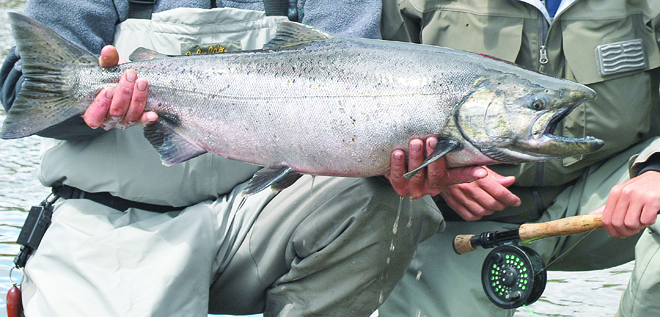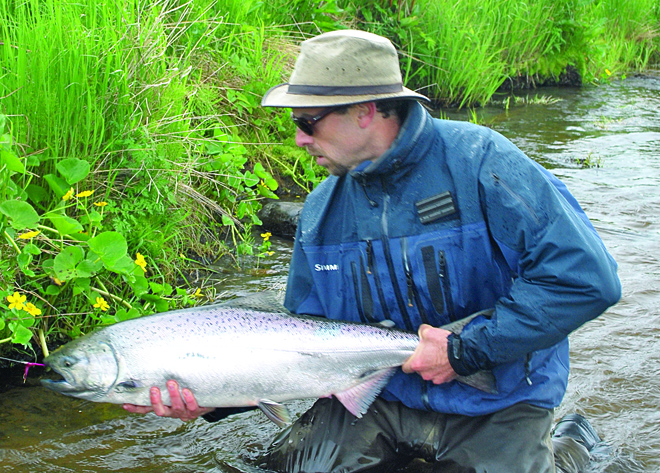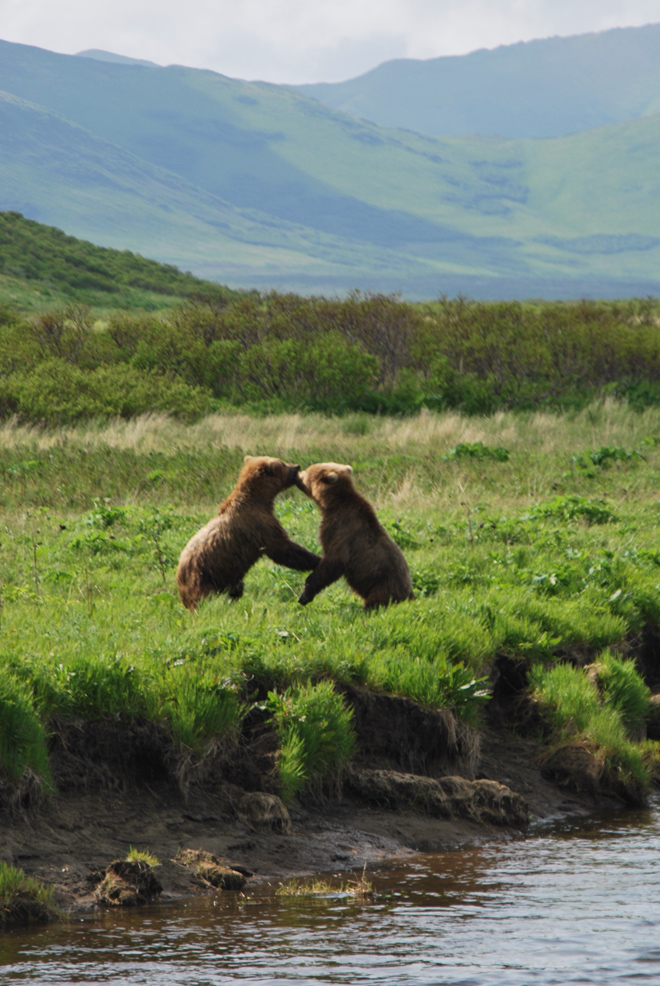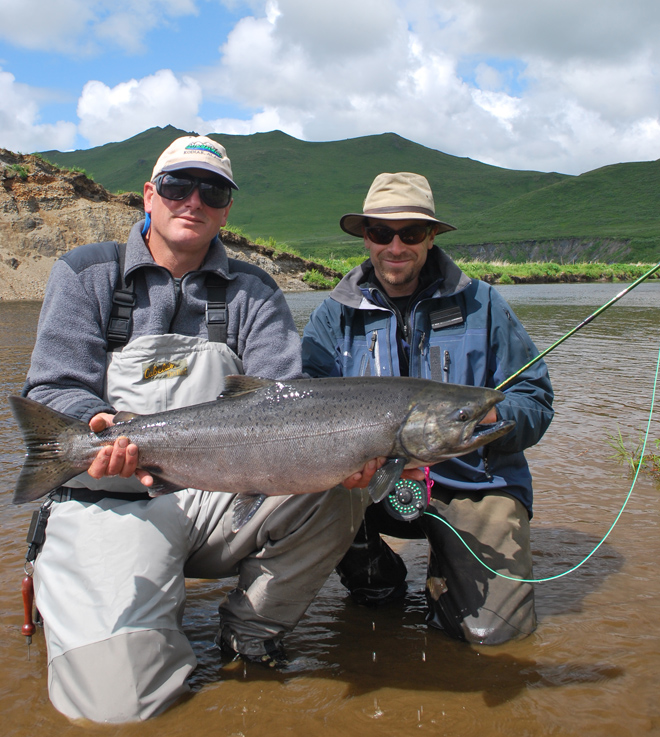The Kings of Kodiak
By Troy Letherman
It’s cool in the shadows of Kodiak twilight,calendar be damned, but having settled on fleece rather than Gore-Tex—constant shilly-shallying between rain and sun had marked the day’s atmospheric conditions—I’m at last free to enjoy a little late-night stroll without fear of soaking through again before returning to my tent. The rest of the camp is asleep, which is where I should be during this pause between the lackadaisical setting and the altogether more explosive rise of the sun that will inaugurate the longest day of the year. Instead, hoping to go without a sudden test of the electric bear fence, I’m pacing the thirty total yards of camp boardwalk in unlaced hiking boots, watching the once pronounced features of the valley retreat into the gloaming, trying to recall the details of a day just spent.
My second swing through the long upriver riffle had barely gotten started when the line jumped from the surface and sliced across the stream toward the far bank. A mercurial sockeye hen, six pounds and colored like quicksilver, bent at least five different directions during her first leap, clearing water by a couple body lengths. A second run and my line finger burned the way it should early in the year, the drag managed, new knots held.
Release, and another cast, another fish, another workout for the equipment, not to mention my shoulder, forearm and wrist. Subsequent points of action are muddled, returning only in the fits and starts of a memory overloaded with stimulation. It’s as if the third bear, a blondish boar that popped out on our gravel bar for a quick peek at the stacked up reds, or the four Sitka blacktail deer that wandered in and out of the brush along the ridge across the river, or the seventh or maybe seventeenth fish had tripped some kind of mental fuse, blacking out several moments of imagination. Only fragments remain—some color, some laughter and the sounds of fishing at its hottest: fly line breaking from the surface, the whine of reels, a whoop, a holler, a splash.
Grappling for details, I again find relevance in a favorite Cormac McCarthy quote: “You forget what you want to remember, and you remember what you want to forget.”

No matter, I decide. I twirl the remnants of a Crazy Charlie between my forefinger and thumb as I walk through the unfolding night, and a simple glance at the fly’s condition tells me there was much more to the day than I can recall at the moment. For one, there are hardly any of the pink bucktail wing fibers remaining, the rest having departed with the released sockeye. The body, once tinsel, Flashabou and translucent ribbing, is now mostly bare hook. Pliers had obviously made an appearance or two, and apparently, done as much harm as good. This is a fly with history, if only a day old. The pattern, too, has some history, though almost none of it here. Bob Nauheim, utilizing the bead-chain weighting techniques popular with steelheaders around his Northern California home, designed the fly in the late 1970s for the bonefish of the flats surrounding South Andros Island. Even accounting for the fact that fly fishing is undergoing the same globalization of community that affects the rest of humanity’s activities, it seems ludicrous for it to turn up out here, on a roadless corner of the Kodiak coast, wreaking havoc with the Alaska sockeye, which presumably haven’t spent a great deal of time feeding on glass minnows in the Bahamas.
But, of course, that’s nothing when it comes to bewildering displacement—twenty-four hours prior I was snug on the couch at home, surrounded by the most modern comforts, watching an entire season of a television series just by pushing a button on my cable remote. At the same time, a room away, one of my sons was playing Xbox Live with a kid in Indiana; another son watched a soccer game from Russia on the computer. Now I’m standing in a place so quiet I’ve forgotten how to think, where the length of my nocturnal excursion is restricted by a fence meant to keep one of Earth’s largest omnivores from ransacking the place. Out here, beyond the gear we brought with us, the nearest nod to modernity is probably an Alutiiq village of 58 souls that was first established as a Russian sea otter hunting community called Kashukugmiut. It’s doubtful that anyone there cares about bonefish flies, the form of Zenit St. Petersburg or Showtime On-Demand.
In the last of the light afforded the valley, I take a final glance upstream and see a generously proportioned bear padding atop a cut bank, his shape charcoal against a gunmetal sky. The river running just below camp has turned the color of ink, and every now and then, as I think about the casts made and the fish caught earlier in the day, I hear the sound of fresh salmon rolling deep in the home pool. It’s my first time here, but that’s of dubious consequence—to me, a piece of flowing water feels like good conversation. The rolling fish, the rings and ripples they leave behind—these are the comfortable silences that tell me I’m with an old friend.
It might be a little much—this is just a fishing trip, after all—but as Herman Melville, McCarthy’s favorite, wrote: “Meditation and water are wedded forever.”
I think Cormac would agree. After all, he first turned seriously to literature during the two years he spent in Alaska with the Air Force, and I’d be surprised if the sweep and the scale of things up here didn’t give him a little push. This state does seem to bully folks into more contemplative moods, and not so curiously, I find myself thinking less about the sockeye I caught earlier in the day, or the kings I hope to catch when the sun returns from the other side of the hills, but rather about the confluence of sheer chance that could bring a guy like me to a place like this, and then let me fish.
A collection of Weatherport tents sits on a small bluff overlooking the Ayakulik River, which flows through a slender valley above Olga Bay on the southwestern edge of Kodiak Island. The camp is just downstream from the river’s convergence with Red Lake Creek, and a mile or two above its meeting-up with the trickle of Bare Creek, a popular floatplane-landing and do-it-yourself-camping zone within the Kodiak National Wildlife Refuge. Such has been the popularity of the place during king season that securing a spot at the AlpenView Wilderness Lodge outcamp is typically not easy, this because of an accumulation of circumstances that could make the Aurora Borealis appear pedestrian.
Only two rivers on Kodiak support native populations of Chinook salmon, the Karluk being the other, and it’s generally conceded that the Ayakulik offers better holding water and more fish under decidedly less pressure. A classic fly-fishing stream, and smaller than the Karluk, here anglers are presented with the opportunity to sight-fish to kings in terrific numbers, minus the need for herculean casts or brutish gear. Some choose to go it alone, pitching up with the latest in bivvy paraphernalia on the grassy shelf near Bare Creek, but considering some dicey weather, the largest bears in the world at an all-time population high and the typical benefits of fishing with an experienced hand who knows the river, a call to Dave Jones seemed prudent.
Sideways rain and a ten-degree temperature drop shepherded in the Summer Solstice, necessitating both the fleece and the rain gear for the morning walk to breakfast and then the boats. Dave, not to be confused with the Davy referenced both by Melville in Moby Dick and countless others prone to nautical superstition, motored us to a point just below the Bare Creek confluence, where we tied the jetboat to willows jutting from a high bank and made a short hike to the aptly-named Boulder Hole. This portion of the 28-mile-long Ayakulik produces some of the most productive Chinook fishing, with moderately deep runs, a series of long, sweeping outside corners and some stretches of traditional riffle-pool construction. The fact that most of these locations have names gives it away—you can probably find a Guide, Boulder, Swallow and Horseshoe hole on most decent salmon rivers in the West, though I’ll admit I’ve fished in few places called Bird Island. I’ve also fished in few likelier-looking king locales, no matter the monikers handed out.

Half an hour into the fishing, Don Shaffer picked up his first-ever king on the fly. A regular visitor from coastal Oregon, Don was on a roll with the fly-fishing firsts—he’d caught his first sockeye on the fly the day prior, and shortly after broke his first fly rod, which was actually a loaner given to him by his son for the trip. Next through the run, Mark Vickstrom of Kodiak put an orange Vibrax to work and quickly doubled the group’s total. Marcus Weiner of Fish Alaska made it three-for-three when his offering swung into the maw of a waiting 25-pound chromer. The only one of us choosing to utilize a Spey rod, Dave moved below and fished the downstream riffle, pulling his own good king off the gravel bottom. The rampant success that we had encountered with the reds the day before was never a realistic target—for instance, “I just want to see how many I can hook in a single drift,” Marcus had told me at one point, after shaking off his second sockeye in about ten feet of seam. King fishing, though, is not supposed to be like anything else.
The largest and longest-lived, but also the least abundant of the five species of Alaska’s Pacific salmon, Chinook are robust, full-bodied fish, with broad and moderately forked tails and teeth of manifest development. Another signature characteristic of adult kings is the erratic black spotting along the back, dorsal fins and on both lobes of the caudal fin. These spots—highly irregular in size and shape—only occur above the lateral line. Most Ayakulik kings spend from three to five years in saltwater, sometimes undertaking extensive migrations, roaming thousands of miles into the North Pacific and Bering Sea. Others, the feeder kings caught by Kodiak saltwater anglers, might remain in inshore waters for the duration of their marine existence. No matter where they are, however, king salmon at sea experience rapid growth, averaging as much as a pound per month, preying on sand lance, pilchards, herring, smelts, sticklebacks and anchovies, as well as walleye pollock, Pacific cod, tomcod, rockfish, squid, euphausiids, amphipods and crab larvae. The Ayakulik return runs from late May through mid-July, with half the immigration usually passing the lower-river weir by June 15 of a given year (the Karluk, on the other hand, peaks slightly later, typically from mid-June through early July).

By now preoccupied with a lust for their natal spawning grounds, these fish are no longer actively feeding and must be enticed with patterns that elicit a territorial response or imitations that are so harmless—or realistic—in appearance that they’re picked up almost reflexively. Personal preference represents the significant criteria in design, and use, as an angler that feels good about his fly will almost always out-fish the skeptic.
In this case, it seems we had a group of true believers. After salmon-spread sandwiches on the gravel bar at Boulder Hole, we fished down to Sparrow Hole, where the river moves leisurely and slides past a tall, auburn-colored bluff. Here we find one of the secrets of holding kings: depth. A uniform gravel bottom starts shallow on the inside of the corner and gradually slides away towards the bluff across the river, the water going from eight inches to eight feet deep in the space of a single decent cast. Using a purple, articulated Jumbo Critter, kind of my own personal Ishta devata, I came tight to my largest fish of the trip in only the third drift. A serial buffoon, I broke it off at the beach,but after a quick puja to the Jumbo Critter, I made as close to the same cast as possible, finding redemption in a second buck with a taste for purple.
Even accounting for faith in the fly, and whatever benefits are to be gained from worship, the fishing should not be this good. True, the Ayakulik is one of the most remarkable Chinook rivers on Earth, regularly kicking out twenty-fish days for its visitors—a ten-year average of 13,400 spawners has something to do with that, as does lack of pressure and the user-friendly nature of the stream. But the river also failed to meet its minimum escapement goal of 4,800 fish in two of the past three years, and according to weir counts, this season’s run is teetering in the brink of collapse. Only 289 kings had crossed ADF&G’s magic line as of three days ago, though today’s count was up to 900-plus. Luckily, Dave Jones is proving to hold talismanic powers over the Ayakulik kings, and we continue to catch fish.

Coupled with the news from other parts of Alaska, where kings were again up to something of a vanishing act, the last thing I wanted to consider was another poor turnout for the Karluk (already closed to all fishing) and the Ayakulik (catch-and-release-only since June 11), two crown jewels of the Kodiak freshwater fishery. Unlike the Endangered Species Act-protected stocks of the Pacific Northwest, Alaska’s Chinook populations had for the most part remained stable, providing a sport harvest that has reached 100,000 or more fish, subsistence catches up to 90,000 fish and a commercial haul of over half-a-million kings. Now, recalling how Russell Chatham had to write a new introduction to his great book, The Angler’s Coast (which basically amounted to a eulogy: “If these stories were originally written as documents of things ongoing, they now record conditions only vaguely remembered.”), I throw myself into proving the weir-counts wrong. The only problem is run after run comes up empty. At some point, I even succumb to the angler’s glitch of believing that ever-longer casts are the solution. Pretty soon I’m ripping my undershorts just to pile line into the opposite bank, and catching nothing.
It seems killer whales are having a similar problem. Seriously.
New research published in the Royal Society Biology Letters suggests that some orca populations favor king salmon so much that the whales will actually die when Chinook numbers drop. Apparently, though these apex predators may consume a variety of fish species and mammals, many are also exceedingly specialized hunters that favor kings as a primary year-round food source, due to the species’ high concentration of lipids. The whales home in on kings by using echolocation—creating a sound in order to produce echoes, which are distinct among the different salmon species. Swim bladders, pretty much gas bags, are the key to all this, as the study revealed that echolocation tuned especially well to information released by each salmon’s bladder. Gas bags, explained the study leader, are probably the best reflector of acoustic energy underwater.
I hate lots of things, but nothing quite as much as gas bags.
Dave, however, reminds me what a fish looks like by landing a pair of nice kings as we near a dramatic, deep-water oxbow. Marcus hooks one as well, and brings it to the bank for a celebratory photograph. Mark pulls a surprise steelhead. I take all the photos, while wishing it were 2004—not only would I be younger, but I’d presumably have a chance at one of those 24,000 fish. But, fish or not, I do know I’m better for this—just as I’m better for Cormac McCarthy coming to Alaska and turning to literature, and better for having read him, because now I understand that between the wish and the thing is the river.
And this, more than the deer and the bears, the sockeye and the kings, is what I want to remember. I’m better for every minute I can spend on the Ayakulik, and so I cast again.
###
More information on AlpenView Wilderness Lodge and the Ayakulik outcamp can be found at www.alpenview.com. Troy Letherman is the editor of Fish Alaska magazine.
